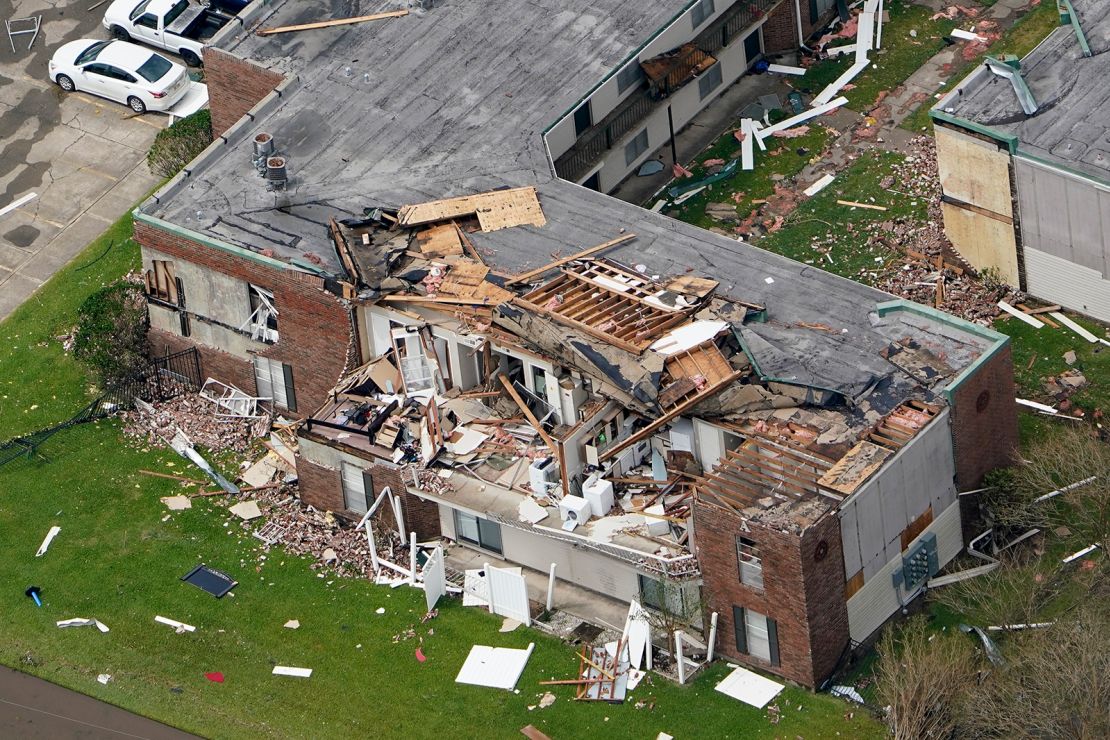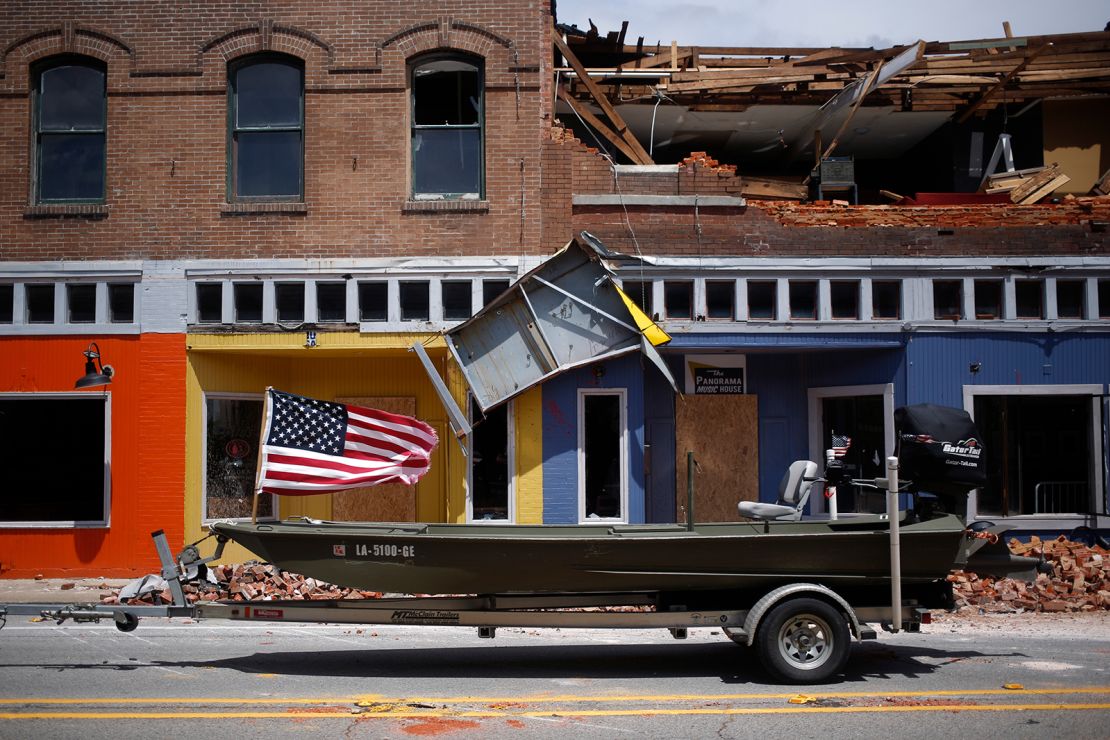The devastation of Laura in Louisiana and Texas has felt “like a week out of a bad science fiction novel,” one mayor said as the storm, now a tropical depression, wends its way Friday into the Mid-South.
Nearly 600,000 residents in the two states remain without electricity, and 8 million are still under a flash flood watch, with heavy rain and isolated tornadoes forecast.
A heat advisory is in effect until Saturday night for more than 30 million people in Texas, Louisiana and Arkansas, the National Weather Service says. Heat indices could reach 110 degrees Fahrenheit on Friday and Saturday.
Water treatment plants in the Louisiana city of Lake Charles were damaged, with “barely a trickle of water coming out of most faucets” as residents also contend with widespread power outages, Mayor Nic Hunter said late Thursday in a Facebook post.
“If you come back to Lake Charles to stay, make sure you understand the … reality and are prepared to live in it for many days, probably weeks,” the mayor wrote. “‘Look and Leave’ truly is the best option for many.”
A Lake Charles hospital also had to evacuate all patients to hospitals across the state as it dealt with damage caused by the storm, according to a post on Lake Charles Memorial Health System’s Facebook page.
Their “Emergency Department will continue to stay open,” according to the post, “and patients will either be treated and released or treated and transferred to another hospital.” The Louisiana Health and Human Services Department is sending a disaster medical assistance team that will set up outside the ER Saturday to assist with emergency medical services for the community.
Laura made landfall early Thursday near Cameron, Louisiana, as a Category 4 hurricane, packing winds of about 150 mph. Areas across the coast were pounded by ferocious winds and an unforgiving storm surge that left some neighborhoods littered with debris.
Gov. John Bel Edwards toured the worst-impacted areas of his state. “The last couple of days have been hard, and the road to recover won’t be easy. But we will recover,” he said Friday morning in a tweet.
Edwards also warned of “risks left behind by the storm.” He has expressed concerns this week about Covid-19 after Laura.
Edwards sent a letter to President Donald Trump Friday requesting a major disaster declaration for 23 parishes, which was approved by the President late Friday. The declaration allows the Federal Emergency Management Agency to assist those affected by the storm, according to a news release from the governor’s office.
At least 10 deaths were reported across the state. Four people died after trees fell, including a 14-year-old girl in Vernon Parish; a 51-year-old man in Jackson Parish; a 60-year-old man in Acadia Parish; and a 64-year-old man in Allen Parish, authorities have said.
Four people died in Calcasieu Parish due to carbon monoxide poisoning, authorities said, giving no other details.

Tropical depression heads toward Missouri
Early Friday morning, Laura crossed Arkansas and trekked toward southeastern Missouri as a tropical depression with winds of 35 mph. In preparation for the storm, Arkansas sent out search and rescue teams along with National Guard members to assist.
Throughout the day, the storm will head across Kentucky and continue eastward until it heads off the coast through New Jersey and Delaware by Saturday evening.
Laura’s expected to dump up to 6 inches of rain over central and northern Arkansas Friday, while parts of southern Louisiana, Mississippi and Missouri may see isolated rain totals of up to 5 inches.

The rain may likely lead to flash flooding along streams, roads and urban areas and to moderate river flooding in parts of Louisiana, Mississippi and Arkansas, the National Hurricane Center said.
“The heavy rainfall threat and flash and urban flooding potential will spread northeastward into the middle-Mississippi, lower Ohio and Tennessee Valleys, and Mid-Atlantic States Friday and Saturday,” the center said.
Parts of Tennessee, Kentucky, Missouri, Arkansas, Alabama and Mississippi are at the highest risk for tornadoes Friday, while that risk will shift Saturday to Virginia, North Carolina, Maryland, New Jersey, Delaware and parts of Pennsylvania.
Electrical power may take up to two months to restore in Cameron Parish, Louisiana, according to Ashley Buller, assistant director of Parish Emergency Preparedness. There currently is no running water or electrical power in the parish.
‘I’ve never seen this kind of damage’
Many who evacuated ahead of the storm were afraid of what they may find when they return to their homes. The storm damaged roofs and walls, ripped street signs from the ground, snapped trees and bent lamp posts.
In Lafayette, Louisiana, Brandon Montgomery’s home was spared Thursday from flooding and wind damage. But his neighbor wasn’t as lucky: At least a foot of water flooded that home.
Flooding in their neighborhood began overnight Thursday, and by that morning, the water had risen to about 3 feet high.
In Lake Charles, which was hit hard, some buildings were leveled to nothing but scraps of wood, CNN affiliate WVUE reported.
Latoyia Jackson and her sister were urged by their family to evacuate ahead of the storm, they told the affiliate. The two have seen pictures of the community, and Jackson feared she’d go back and find that “everything is gone,” she said.
In downtown Lake Charles, two residents couldn’t find a single person to talk to amid the devastation, they told WVUE.
“I’ve never seen this kind of damage,” one said. Footage of the city shows store signs on the floor, shattered windows, destroyed tents and debris all over the roads.
“There’s a lot of damage. People are going to need a lot of help around here,” said Paul Heard, who was in Lake Charles as the storm came in. Heard left his house and took shelter in his car just as the storm was pulling parts of the roof early Thursday, he said.
As he watched from 25 feet away, he “could see my roof was heaving up and down several inches,” he told CNN.
CNN’s Rob Shackelford, Jason Hanna, Madeline Holcombe, Theresa Waldrop, Joe Sutton and Kelsie Smith contributed to this report.






